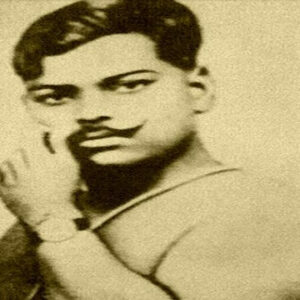Chandra Shekhar Azad was an Indian revolutionary who was widely regarded as the organization’s chief strategist (HSRA). He grew up as a patriotic young man with revolutionary ideas during the British colonial rule of India. From an early age, he was a self-sufficient individual who became active in the Indian nationalist movement. He was only 15 years old when he was arrested by the police for his involvement in Mohandas K. Gandhi’s noncooperation movement and subjected to a severe flogging. His determination to fight for the independence of his country grew stronger over time, and he joined the radical Hindustan Republican Association (HRA). He took part in several violent protests against the British Raj and served as an inspiration and mentor to Bhagat Singh, the budding revolutionary. Azad reorganized the HRA under the new name of Hindustan Socialist Republican Association following the deaths of HRA founder Ram Prasad Bismil and three other prominent party leaders, Roshan Singh, Rajendra Nath Lahiri, and Ashfaqulla Khan (HSRA). Azad was a wanted man in the eyes of the British police due to his revolutionary activities; however, he managed to evade arrest for several years. He was adamant about never being apprehended alive and shot himself when he found himself on the verge of arrest following a comrade’s betrayal.
Childhood & Adolescence
He was born Chandra Shekhar Tiwari on 23 July 1906 in Bhavra village, Madhya Pradesh’s current Alirajpur district. Sitaram Tiwari and Jagrani Devi were his parents.
He learned archery as a young boy from the tribal Bhils of former Jhabua, a skill that would prove invaluable during the armed struggle against the British. His mother desired that he become a great Sanskrit scholar, and thus he was sent to study at Banaras’s Kashi Vidyapeeth.
From an early age, he was a fervent supporter of India’s independence struggle. The 1919 Jallianwala Bagh Massacre in Amritsar, in which the British army killed hundreds of unarmed civilians and wounded thousands, infuriated the teenage boy, and he became convinced that resorting to violence against the British was perfectly acceptable.
When Mohandas K. Gandhi launched the Non-Cooperation Movement in 1921, he was a 15-year-old student. He joined the movement and was arrested as a result of his involvement. When British officers questioned him about his personal details, he stated that his name was “Azad” (The Liberated), his father’s name was “Swatantrata” (Independence), and his residence was “Jail.” From then on, he was known as Chandra Shekhar Azad.
Activities Revolutionary of Chandra Shekhar Azad
In 1922, the Non-Cooperation Movement was suspended. This greatly enraged Azad, who subsequently resorted to more aggressive forms of protest. He believed that socialism was India’s future and devoted himself entirely to the independence movement.
He met Ram Prasad Bismil, a revolutionary who had founded the Hindustan Republican Association (HRA). He joined HRA and became an active member after being impressed by the organization’s ideals.
He committed several violent acts against the British in collaboration with other like-minded revolutionaries, including the 1925 Kakori Train Robbery and the attempt to blow up the Viceroy’s train in 1926.
Azad also met a young revolutionary named Bhagat Singh, who shared many of Azad’s values and beliefs about the freedom struggle. Azad conspired with Singh and others to assassinate J.P. Saunders in Lahore in 1928 in order to avenge the death of Lala Lajpat Rai, one of the leaders of the Indian independence movement.
Azad, a skilled archer, established a base in Jhansi for a time. He trained other members of his group in shooting practice in a forest near Jhansi. He was able to establish a positive rapport with the local villagers while using the alias of Pandit Harishankar Brahmachari.
He aided in the consolidation of his revolutionary group by recruiting Sadashivrao Malkapurkar, Vishwanath Vaishampayan, and Bhagwan Das Mahaur. Additionally, he maintained close ties to Congress leaders such as Raghunath Vinayak Dhulekar and Sitaram Bhaskar Bhagwat.
In 1928, following the death of Ram Prasad Bismil, Azad and several of his associates, including Bhagwati Charan Vohra, Bhagat Singh, Sukhdev, and Rajguru, reorganized the HRA as the Hindustan Socialist Republican Association (HSRA). The HSRA’s primary objective was to realize the socialist dream of an independent India.
In early 1931, he met Jawaharlal Nehru to discuss the terms of the forthcoming Gandhi-Irwin Pact. Nehru disagreed with Azad on certain points, despite the fact that he provided financial support for his work.
Significant Works of Chandra Shekhar Azad
Chandra Shekhar Azad was a well-known revolutionary patriot who was best known for renaming the Hindustan Republican Association the Hindustan Socialist Republican Association (HSRA) and for training and mentoring other revolutionaries such as Bhagat Singh. Azad was the HSRA’s chief strategist until his death in 1931.
Death & Enduring Legacy
He was at Allahabad’s Alfred Park on 27 February 1931 with his revolutionary friend Sukhdev Raj. Suddenly, he was surrounded on all sides by police, and a gun battle ensued. Azad murdered three police officers but was mortally wounded defending himself and Sukhdev.
Despite his severe injuries, he assisted Sukhdev in escaping. When he realized he had only one bullet left in his gun and was unable to flee, he shot himself to death, keeping his promise to never be apprehended alive. Already a popular revolutionary figure, his assassination elevated him to the status of a martyr.
In his honor, the park where he died was renamed Chandra Shekhar Azad Park. Numerous schools, colleges, and other institutions throughout India bear his name as well.
Chandra Shekhar Azad has also been portrayed in a number of Indian films, including ‘Shaheed,’ ’23rd March 1931: Shaheed,’ and ‘The Legend of Bhagat Singh.
Estimated Net Worth
Chandrashekhar Azad Ravan is one of the wealthiest politicians and is ranked among the most popular. Chandrashekhar Azad Ravan’s net worth is estimated to be around $1.5 million, based on our analysis of Wikipedia, Forbes, and Business Insider.


